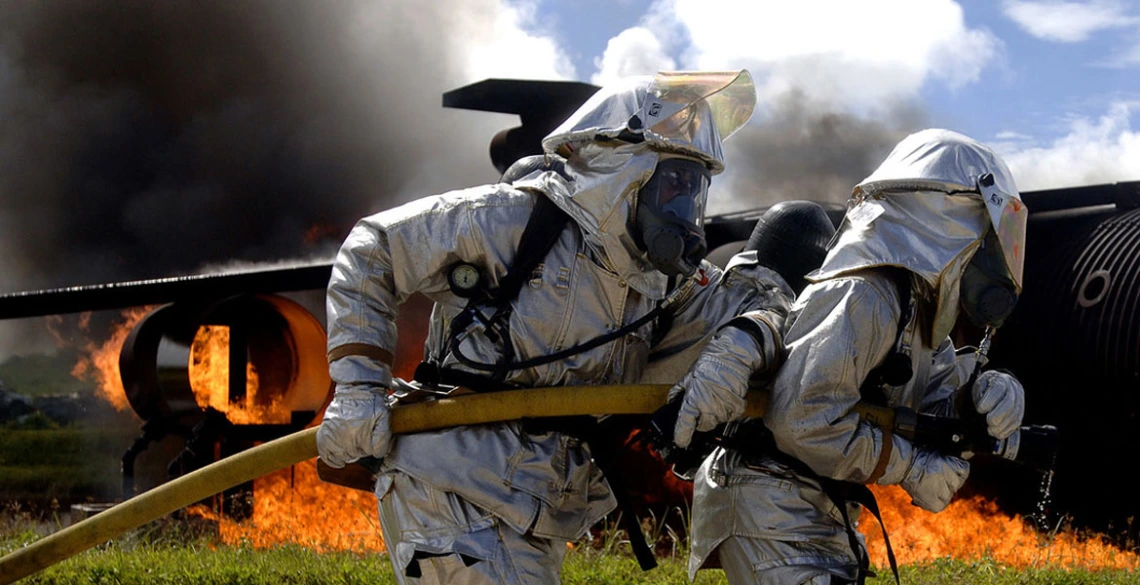The Sound of Destruction
What do kidney stones, a shrimp’s lunch, and fire-fighting foam have in common? The answer lies in the destructive power of sound waves, which UA College of Engineering researchers are investigating as a means of eliminating toxic chemicals

Air Force firefighters work to put out a fire as part of a simulated aircraft crash during an exercise at Andersen Air Force Base in Guam. The routine exercise is conducted at the base a few times a year to sharpen the mobility and wartime capabilities of participating servicemembers. (U.S. Air Force Photo by Staff Sgt. Bennie J. Davis III)
Researchers at the University of Arizona College of Engineering have come up with a novel way to help the U.S. Air Force dispose of stockpiles of dangerous chemicals -- using nothing more than sound waves.
The Air Force has a large stockpile -- almost 11 million liters -- of fire-extinguishing foam, which contains environmentally damaging organic compounds. Manish Keswani, an assistant professor in the department of materials science and engineering, and Reyes Sierra, a professor in the department of chemical and environmental engineering, have been awarded a $243,000 contract by the Air Force Civil Engineering Center to destroy the chemicals using a novel sonochemical process, which uses sound waves to break down complex and toxic molecules into nothing more than carbon dioxide and water.
“Sonolysis relies on the process of cavitation for its success,” Keswani said. “Under certain conditions, sound waves cause the formation of small bubbles that rapidly implode and release an intense shock wave that produces enormous amounts of heat energy and a variety of highly active radicals, which can completely destroy adjacent material.”
Cavitation is used in certain medical procedures and is also found in nature. Shock-wave lithotripsy relies on cavitation to destroy kidney stones, and mantis shrimps use cavitation when hunting their next meal. The shrimps strike with such velocity -- about the speed of a bullet -- that they generate cavitation bubbles in the water between themselves and their target. Even if they don’t make a direct strike, the resulting shock waves are enough to stun or kill their prey.
The heat energy unleashed by cavitation breaks down the bonds that tie large molecules together, such as the perfluoroalkyl sulfonates and carboxylates, or PFCs, found in fire-fighting foams. These toxic PFCs are hard to break down and tend to persist in the environment, and in body tissue, which is why the Air Force will be investigating cavitation as a cost-effective method of producing temperatures in excess of 10,000 degrees Fahrenheit, more than enough to incinerate the problem chemicals.
“One novel aspect of our acoustic technology is the use of multiple sound frequencies to treat large quantities of fire-fighting foam,” Sierra said. Current sonolysis techniques use ultrasonic (20-100 kHz) or megasonic (> 0.5 MHz) frequencies, but results have been disappointing in terms of the volume of material that can be treated using these frequency ranges.
Keswani and Sierra will study the effectiveness of a dual-transducer system they have developed. It uses both ultrasonic and megasonic frequencies and can be scaled up to treat the Air Force’s large stockpile of toxic fire-fighting chemicals. Their objective is to develop a system that will produce the required high incineration temperatures and desired concentration of active oxidizing radicals while consuming the least amount of energy. They have also developed an electrochemical probe that can quickly and economically identify the most effective chemical and acoustic conditions for degrading the toxic chemicals.

